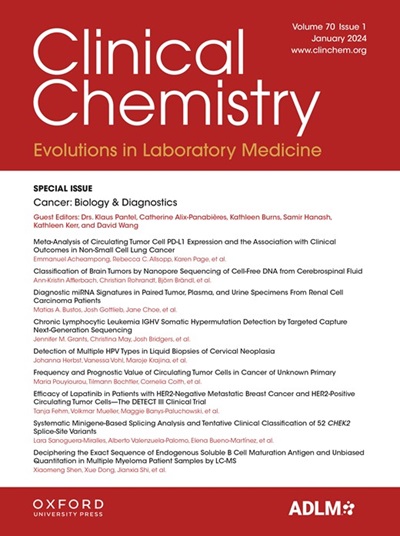A-355 使用 QPlus 和 QStat 血盒在定量系统上分析动脉和静脉全血样本的比较
IF 6.3
2区 医学
Q1 MEDICAL LABORATORY TECHNOLOGY
引用次数: 0
摘要
背景 Quantra 止血系统(HemoSonics, LLC)是一种基于血盒的粘弹性检测系统,用于监测全血样本的凝血状态。该系统与 QPlus 和 QStat 血盒的临床性能已在使用静脉血样本进行外科手术的患者身上得到证实。不过,根据外科手术的性质,动脉或静脉样本可能更便于检测。目前,Quantra 系统的两种样本之间是否存在差异尚不清楚。本研究比较了从接受心脏或肝脏移植手术的患者身上同时采集的静脉血样本和动脉血样本的 QPlus 和 QStat 参数测量结果。方法 根据 CLSI EP09 进行了两项研究。心脏研究招募了 50 名接受心肺旁路手术的成年患者,以评估 QPlus 参数。在两个时间点采集了相匹配的动脉和静脉样本:旁路过程中和使用兴奋剂后。肝脏研究招募了 25 名接受肝脏移植手术的成年患者,以评估 QStat 参数。在三个时间点采集了匹配的动脉和静脉样本:基线期、无肝期和再灌注期。所有动脉样本均取自现有的动脉导管,而静脉样本则取自旁路回路的静脉侧或中心静脉导管(近端端口,以尽量减少输液污染)。通过线性回归分析和均值比较(配对 t 检验)来评估两种样本类型是否提供了相同的结果,结果表 1 提供了静脉样本和动脉样本所测定的各项参数的均值。所有参数在样本类型之间均无明显差异(P&;gt; 0.05)。此外,线性回归分析表明,各参数的结果之间具有很强的相关性。结论 这两项研究表明,静脉和动脉全血样本在使用 QPlus 和 QStat 血盒的 Quantra 系统上可得到相同的结果。本文章由计算机程序翻译,如有差异,请以英文原文为准。
A-355 Comparison of Arterial and Venous Whole Blood Samples Analyzed on the QuantraSystem With the QPlusand QStatCartridges
Background The Quantra Hemostasis System (HemoSonics, LLC) is a cartridge-based viscoelastic testing system used to monitor the coagulation status of whole blood samples. The clinical performance of the System with the QPlus and QStat Cartridges was demonstrated in patients undergoing surgical procedures using venous blood samples. However, depending on the nature of the surgical procedure, arterial or venous samples may be more accessible for testing. It is currently unknown if differences exist between the two samples for the Quantra System. This study compared QPlus and QStat parameters measurements in venous and arterial blood samples collected in parallel from patients undergoing cardiac or liver transplant surgery. Methods Two studies were conducted according to CLSI EP09. The cardiac study enrolled 50 adult patients undergoing cardiac surgery utilizing cardiopulmonary bypass to evaluate QPlus parameters. Matching arterial and venous samples were obtained at two time points: during bypass and post-protamine. The liver study enrolled 25 adult patients undergoing liver transplantation to evaluate QStat parameters. Matching arterial and venous samples from were obtained at three time points: baseline, anhepatic and reperfusion phases. All arterial samples were drawn from an existing arterial catheter whereas venous samples were drawn from the venous side of the bypass circuit or from the central venous catheter (proximal port to minimize infusion contamination). Linear regression analysis and means comparison (paired t-test) were used to assess whether the two sample types provided equivalent results, Results Table 1 provides the mean values for each parameter determined for venous and arterial samples. None of the parameters showed a significant difference between sample types (P > 0.05). Additionally, the linear regression analysis show strong correlation between the results for each parameter. Conclusions Both studies demonstrated that venous and arterial whole blood samples provide equivalent results on the Quantra System with the QPlus and QStat Cartridges.
求助全文
通过发布文献求助,成功后即可免费获取论文全文。
去求助
来源期刊

Clinical chemistry
医学-医学实验技术
CiteScore
11.30
自引率
4.30%
发文量
212
审稿时长
1.7 months
期刊介绍:
Clinical Chemistry is a peer-reviewed scientific journal that is the premier publication for the science and practice of clinical laboratory medicine. It was established in 1955 and is associated with the Association for Diagnostics & Laboratory Medicine (ADLM).
The journal focuses on laboratory diagnosis and management of patients, and has expanded to include other clinical laboratory disciplines such as genomics, hematology, microbiology, and toxicology. It also publishes articles relevant to clinical specialties including cardiology, endocrinology, gastroenterology, genetics, immunology, infectious diseases, maternal-fetal medicine, neurology, nutrition, oncology, and pediatrics.
In addition to original research, editorials, and reviews, Clinical Chemistry features recurring sections such as clinical case studies, perspectives, podcasts, and Q&A articles. It has the highest impact factor among journals of clinical chemistry, laboratory medicine, pathology, analytical chemistry, transfusion medicine, and clinical microbiology.
The journal is indexed in databases such as MEDLINE and Web of Science.
 求助内容:
求助内容: 应助结果提醒方式:
应助结果提醒方式:


